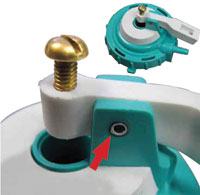
Posted to News on 19th Feb 2015, 00:00
Coiled spring pins provide optimum hinge design
Coiled Spring Pins are particularly well suited for use in both friction and free fit hinges. To achieve optimum long-term hinge performance designers should observe some simple design guidelines. Christie Jones and Michael Pasko of Spirol explain.

>There are two primary types of hinges. A free fit hinge has little to no friction or drag when the latch or handle is rotated. Hinge components are 'free' to rotate independent of one another. A friction fit hinge requires interference to prevent free rotation of components relative to one another. Depending on design intent, resistance can vary from a slight drag to a value sufficient to maintain the fixed position of components anywhere in their full range of rotation.
>Although many pin styles are available, coiled spring pins are a good choice for both styles of hinges. Coiled spring pins are manufactured with a seam which is much better for hinges than the gap or slot of slotted spring pins. The seam is inherent to coiled pins because they are rolled with more than one wrap of material. The coiled pin's 'duty' will affect material thickness and the number of wraps, but all coiled pins will possess a seam.
>Some assume that a coiled pin's seam is raised above the surface of the pin. This is not the case. A coiled pin's seam is actually 'tucked' or rolled to ensure the pin remains round. In addition, the seam is prepared with a beveled edge to soften the transition into the 'comma' area. As a matter of fact, a key characteristic of a properly rolled coiled pin is that the diameter of the pin at the seam is equal to or less than the diameter adjacent to the seam. This prevents the edge of the material from contacting the inside diameter of the hole wall and prevent skiving when inserted.
>Installed in a hinge application, the pin conforms to the hole in which it is inserted and the 'comma' area is visible as a small gap between pin and hole adjacent to the seam.
>A large percentage of coiled pins are used in hinges and the unique seam configuration is essential to their proper function. Thus, when utilised in round holes, the seam should have absolutely no impact on performance.
>The coiled pin's tucked seam will allow smooth, interference-free rotation of hinge/axle components in the vast majority of assemblies. In most situations where the seam is problematic, it is typically the result of poor installation methods or improper implementation. If excessive compressive force is applied to one part of the pin and not another, seam deformation may occur. This sometimes happens when assemblies are designed such that they do not properly support the pin.
>Similarly, pins can be damaged during installation and this can lead to deformation at the seam. Improper installation technique, equipment, hole condition, or pin material and duty are typical causes. Designers have also attempted to use coiled pins and slotted pins in assemblies where a 'pawl' or lever must ride axially on the surface of the pin as it rotates. The geometry of these components sometimes causes them to catch or 'hang up' on the seam.
>A key design consideration for hinges is that the gap between hinged components should be minimised to reduce clearance and avoid bending of the pin.
>If a free fit hinge is desired, the coiled pin's pre-installed diameter is of negligible importance as pin diameter is determined by the retaining, or smallest hole(s). Coiled pins are functional springs and recovery and retention in free fit locations must be considered. The amount of recovery/retention is dependant upon the diameter of the tight (retaining) hole(s) and the 'free span' of the pin. Free span would be defined as the distance a pin passes through a free fit component. As free span increases, the pin diameter will also increase as it 'recovers' a portion of its pre-installed diameter.
>It is recommended for better load distribution and closer tolerance hinges that the tight fit of the coiled pin be in the outer members of the hinge. The minimum thickness of the outer members should be 1 to 1.5 times the diameter of the pin. If the thickness of the outer members are less than the diameter of the pin, then the tight fit should be in the inside hole.
>To design a free fit hinge, first establish maximum hole size in the retaining component (tight fit). Insert the coiled pin into the retaining component and measure the free diameter of the pin at the center of the span. Add a factor to provide some clearance for the rotating member, usually 0.02mm to establish the minimum diameter of the free hole. Then add the required production tolerance to assign the maximum diameter of the free hole.
>If the tight fit is on the inside member of the assembly, as the pin is installed there becomes a sized and an unsized end of the pin. The end of the pin that has not been inserted through the hole is larger than the end that has been sized by the hole. Therefore, measure the diameter of the unsized end to determine the minimum diameter of the free hole in the outside members.
>In a friction fit hinge, all of the holes should be sized identically within the assigned tolerances. If the manufacturer is unable to maintain the same hole size within each component, the tolerance should be split between the components. It is most common to assign the smaller half of the tolerance to the outside holes and larger half to the inside hole.
>The coiled pin simplifies design as there is no need to incorporate misalignment between holes to achieve friction, as is the case with rigid solid pins. Coiled pins perform best when installed in straight, properly aligned holes. The coiled pin's spring characteristics can be used to achieve exceptional performance and maintain desired fit and function throughout the life of the product.










